Walk for Peace
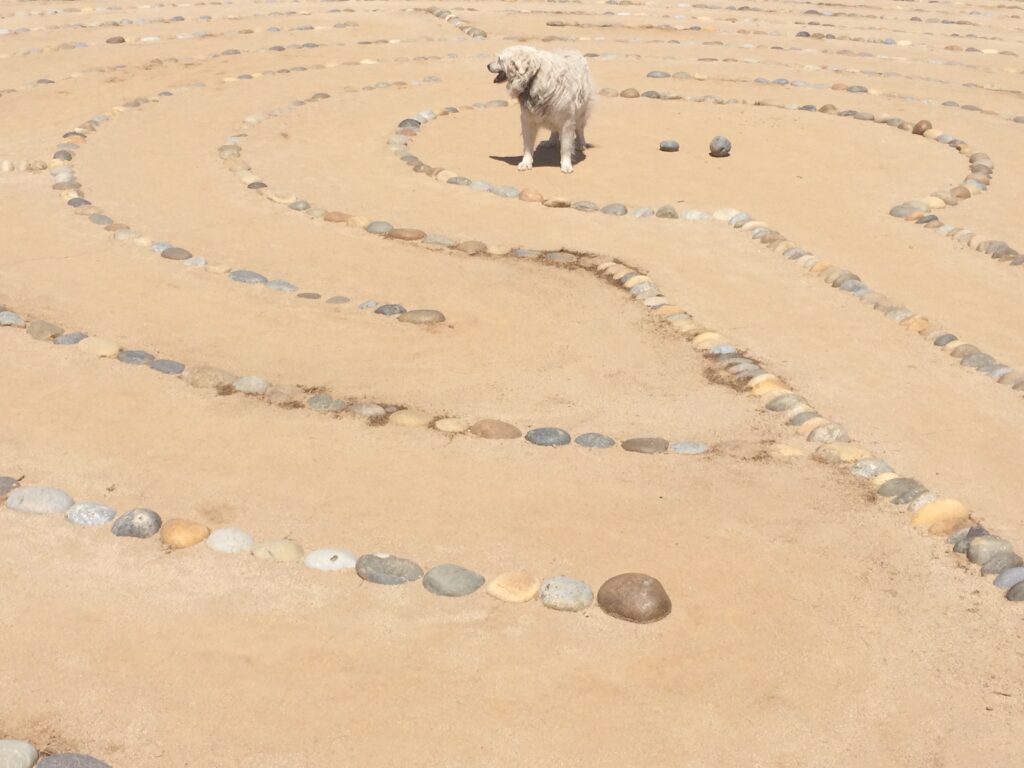
My late dog, Red, helping me research labyrinths. This one is on the coastal bluffs of Santa Barbara
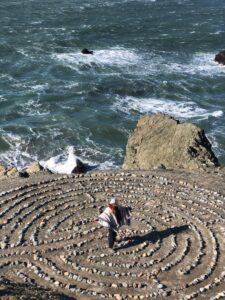
Starr at the hidden labyrinth near the Golden Gate
His command of English was way better than my Japanese, and I respect that, so I hope he didn’t think I was laughing at him. But when Akira visited our farm last summer and looked out over the 110-foot diameter coil of raised beds of lavender dug into the middle of our field, one of his first questions was, “What for, plant in labyrinth?” I smiled and came up with a glib answer that amused me. “Because,” I replied, “after 40 years of commercial row crop farming I’m bored with planting in straight lines.” Akira was touring a range of farms in California and studying their operations as a way of preparing himself to start out his own farm back in Japan and he dutifully recorded my answer in his notebook. I laughed, but now I’m beginning to wonder if maybe the joke wasn’t on me. Months later, Akira is back in Japan starting his own farm and I’m still thinking about that moment, because his question was a good one, and it’s one I’m challenging myself today to answer in a more thoughtful way. Starr and I are inviting the public to come on May 6th and walk the labyrinth that we’ve created as part of “World Labyrinth Day” and I can expect any visitor to ask the same question. So why did I “plant in labyrinth?”
A labyrinth is different from a maze. A maze can be a puzzle path with false starts, dead ends, surprises, and ambiguities. You can get lost in a maze. A farmer might plant a corn maze and charge people a small fee to enter and have fun. You might even be lucky to get out of some mazes alive. Some people say that a maze is a metaphor for life and that we often stumble through our days confused and disoriented. A maze can provoke you to ask yourself, “Where am I going?” George Harrison once sang “If you don’t know where you’re going, any path will get you there.” So what path are you on? Where are you going?
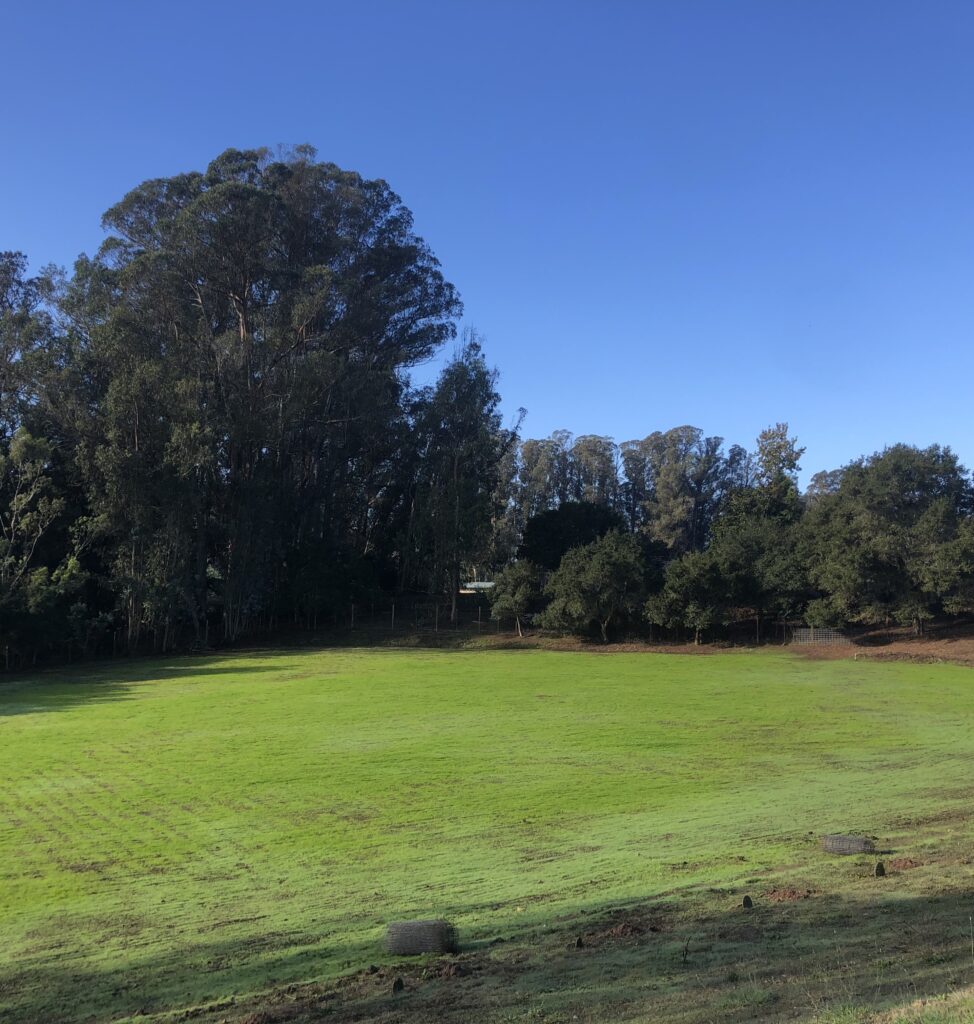
The “before ” shot of the labyrinth field
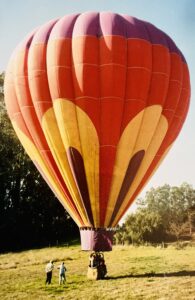
Some visitors have chosen to arrive by air!
By contrast to a maze, a labyrinth has one pathway that – if you follow it long enough- will lead to a center. The labyrinth’s path may appear at times to lead away from the heart or loop back on itself but, if you have the discipline to keep going, if you don’t get tired or bored and quit, you WILL reach the center. Some people say that a labyrinth is a metaphor for life. The labyrinth that Starr and I have made is modeled on the Chartres Cathedral labyrinth that was built in the Middle Ages. But labyrinths have been created by many religious traditions over millennia as meditation tools for spiritual development. Starr and I got started on building and planting our labyrinth when the Covid plague shut down the farm for a while, and the construction certainly kept us busy. Now, after three years, the digging is done, and young lavender plants are beginning to fill in the borders. We invite you to come and walk the labyrinth. Maybe you have questions about the path you’re on and the scent of lavender in the air and sound of the birds singing in the trees may provide some inspiration. Maybe you know where you’re going and you just want to detour down a curving country path and enjoy the roses, cacti and lemon trees that frame the labyrinth. Or maybe you just want to get off of 880 or 101 and sip some lavender lemonade and calm down.
When I was a child the field where Starr and I situated the labyrinth was my grandfather’s sheep pasture. My Grandpa Graydon was born in 1892 and he was a farm worker all his life. He was in that bridge generation from the past to the present and he could drive a team of mules, do basic blacksmithing, repair a gas powered engine, shoot to kill, butcher a sheep or a cow, and grow any vegetable, fruit tree or grain. He lived through two World Wars, several economic depressions, and the Spanish Flu epidemic. He kept going when his sisters died from tuberculosis and he didn’t lose hope when his own children got sick with TB or got sent off to war. My grandpa lived to see Neil Armstrong land on the moon, but he was a practical, “down-to-earth” man of his time, and he had an abiding faith in hard work, in Jesus, and in chemical fertilizers, herbicides and pesticides brought to us by progress and Dow Chemical. I admired my grandfather immensely.
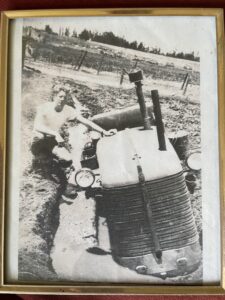
My father as a young man on a ranch somewhere in the Salinas Valley
My father wouldn’t have played much in the field where the labyrinth is now planted because he was bedridden with TB when he lived here. When my dad was healthier, the family lived on other people’s ranches where his father worked as a ranch hand. This place was never enough of a farm to support them. Dad got lucky. He was a veteran of the Korean War and the GI Bill helped him get out of the fields and make his way through college all the way to a Ph.D in Botany. Dad was in that first generation of botanists that looked past the Victorian Era’s Imperialist obsession with “discovering” plants that had been known and utilized by “natives” for millennia and then naming them after themselves. My father thought of himself as a plant ecologist and he and his peers looked at the world holistically as an interrelated web of life where plants and animals and fungi were symbiotically dependent on each other. In an era where humankind could shoot itself into space and look down on the earth, the ecologists were here to echo the wisdom of the first peoples and remind us that we are never above or apart from our relationship and dependence on all other living things. I admired my father immensely. 
Maybe I’m lucky. From the time I was 14 I had a sense of the pathway that I am on. Some people look for years to find a sense of direction. I grew up on a rural University research station for Cal Berkeley, surrounded by scientists of every stripe, as well as that crazy blend of hippies, cowboys, Indians, peaceniks, rednecks, Sikhs, and Buddhists that made up the social collage of upper Carmel Valley in the 60s. From my grandfather and my ranching neighbors I got a love of agriculture and a sense and acceptance of the uncertainty that depending on nature for a livelihood can mean. From my father and the liberal minded Berkeley ecology students that I was surrounded by I absorbed a love of untamed nature, a faith in the scientific method to deepen our appreciation for our place in creation as one organism among many, and a loathing for the smell of pesticides and the indiscriminate damage to the ecosystem posed by unrestrained commercial exploitation of natural resources. It took me a while to discover the appropriate vocabulary to describe the path I’m on, but I knew I wanted to do it all- to raise food and make an honest living off the land but in a way that honored both my father and my grandfather and respected the land we all love.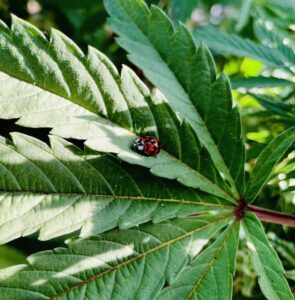
I’m 63 now, so I can look back with a sense of perspective about the path I’ve taken. Sometimes my life has seemed like a maze, but now, with the benefit of age and experience I can see that what seemed like dead ends or false starts turned out to be curves. I once worked for the Cargil Corporation as a field worker and got sprayed by an airplane in the sunflower fields. What could have been a good moment to quit agriculture became a catalytic event to move me further to the left. I found a summer job working on a little biodynamic garden that served Chez Panisse and I earned five dollars an hour. I also found my tribe of people who were working as a community to bring an environmental and social consciousness to the food system. My work gave me a chance to meet visionary and energetic people like Albert Straus, Ellen Straus, Warren Weber, Amigo Bob Cantisano, Mollie Katzen, Patty Unterman, Judy Rodgers, and Alice Waters. With the help of my late wife, Julia, I was able to buy this property from my family, and she built the community-centric business that allowed us to raise our own family here. She and I named our farm “La Mariquita,” meaning “The Ladybug” in Spanish, because our goal was to create a farm that was small and beautiful where the ladybugs were welcome partners.
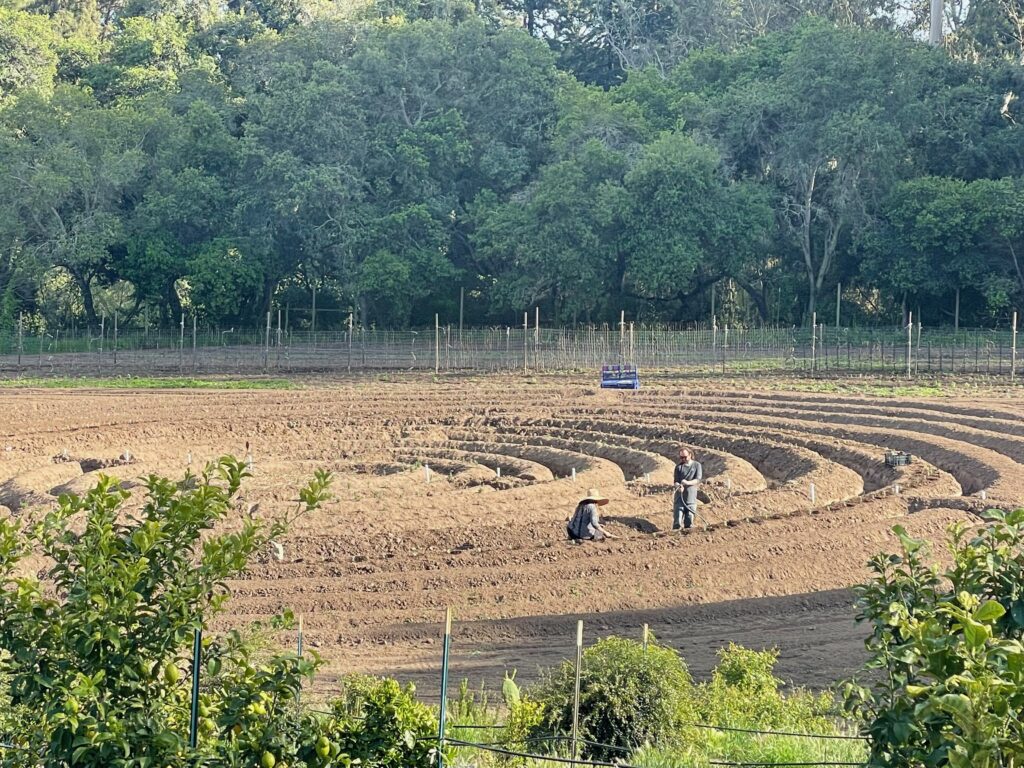
Starr and her son, Malakai, planting the labyrinth
Family farming in a healthy and life affirmative way has never been harder, but it has never been more important either. For me, constructing a huge labyrinth and planting it out with beds of lavender is a life affirming artistic statement, like a spiritually suggestive crop circle that you can see if you’re flying over the world’s problems in a jet on your way to your big conference in Silicon Valley. I’m not against high tech- I’m writing this on a computer- but it can be too easy for the innovators and policy makers to get lost in the seduction of virtual reality and forget the actual reality of earth, air, fire and water down here in flyover country. I think of our labyrinth as a beautiful hello emoji looking up from the land. “Hi Jet plane people. What path are you on? What path are you taking us down?” And besides being a symbol and an invitation, the labyrinth is also a crop producer. Starr has been gathering and drying the lavender flowers. We’ve planted beds of roses and lemons and culinary herbs to embrace the labyrinth, and these crops yield their harvests in their seasons. Plus, farming in straight rows WAS starting to get to me. I wasn’t lying when I told Akira I needed a change, and I feel better for making it.
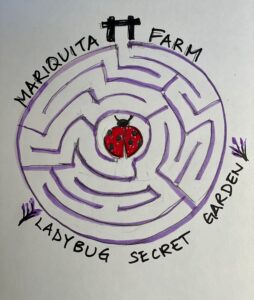
Shelley’s “wabi-sabi” rendering of our vision for the labyrinth.
Starr has her own reasons for working with me to create this gigantic earth art piece, and I’ll let her speak for herself. But I can tell you a few things about her that might put her energy into perspective. She’s the one in the family with an actual degree in Plant and Soil Science. Now she’s a farmer, but she was an organic activist and organizer back when the conventional agriculture crowd greeted those efforts with real hostility. These days, those same companies own the largest organic farms, but that’s a story for another day. And when Starr’s days as an organic farm inspector were in the rear view mirror she focused on event organizing and worked as an artist creating custom pocket shrines for people. Starr and I share a vision of the farm and labyrinth as a living, flowering, fruiting, buzzing, chirping, sweet-scented earth shrine to Mother Nature. When you enter through the front farm gate – or fly overhead- it’s our hope that your first reaction is “Holy Compost! This place is ALIVE!” And we hope it makes you feel more alive too, no matter the path you’re on.
Treat yourself to a special day on Saturday, May 6th when we walk with others around the world for “World Peace” in the Labyrinth. We will also tour the gardens and talk about roses; we have over two hundred rose plants now. And our friend Danielle, a local esthetician and owner of Wild Beauty Cosmetics, who has been buying and using our roses to make rose oil, will do a special rose oil tutorial. All that, and lunch will make for a memorable day at Mariquita Farm. Space is limited and you won’t want to miss out. Tickets available below at:
https://www.mariquita.com/.product/world-labyrinth-day./.
Here’s a link to Akira’s farm blog if you want to see what he’s up to blog: https://agri-step.info
You can also keep an eye on what’s coming up via our two Facebook accounts, Mariquita Farm and Ladybug’s Labyrinth and Secret Garden and you can find us on Instagram @mariquitafarm or @ladybugslabyrinth.
Andy and Starr
© 2023 Essay by Andy Griffin
Photos by Starling Linden & Andrew Griffin


